
ffolas/iStock/Getty Images
Rice and black beans are not only healthy when eaten together, but they are inexpensive and delicious. Individually, rice and black beans are incomplete proteins. Together, however, they complement each other and create a complete protein. As such, they are a good replacement for meat at some meals. Rice and beans also contain vitamins, minerals and fiber.
Brown Vs. White Rice
While there are thousands of rice varieties grown in the world, their nutritional value is similar. All rice has the hull removed. To make rice white, processors must then polish the rice. This removes the bran, along with much of the natural vitamin and mineral content. White rice producers generally fortify white rice by adding nutrients that were removed during processing.
Nutrients in Rice
Rice contains more than 15 vitamins and minerals, including several B vitamins, iron and zinc. It is a good source of dietary fiber and contains no sodium, cholesterol, saturated fat or gluten. Even though white rice is enriched, brown may be a better choice. A 2010 Harvard School of Public Health study found that eating two or more servings of brown rice weekly lowered type 2 diabetes risk, while eating white rice increased the risk. Fiber -- like that contained in the bran removed during polishing -- is known to lower diabetes risk because it slows absorption of sugar into the blood.
Nutrients in Black Beans
Black beans are a good source of vegetable protein, fiber and many vitamins and minerals, including B vitamins, iron, calcium, magnesium, potassium and phosphorus. Black beans do not contain much methionine, one of the essential amino acids, but when you combine your black beans with the methionine in brown rice, you get a complete protein. A cup of black beans contains only 2 mg salt and less than 1 gram of total fat, most of which is unsaturated.
Ways to Serve Rice and Black Beans
Rice, when topped with black beans, chopped onions and tomatoes, makes a nutritious entree. You could also add steamed carrots, lightly cooked spinach or any vegetables that appeal to you. Rice and beans can pair up in other ways. By cooking a large batch of black beans and freezing some for later use, you can have them available to drop in soups and casseroles along with rice. Try adding rice and black beans to a tossed salad. Mix mashed beans, rice, eggs, crumbs, chopped onion and seasonings to make homemade veggie burgers or veggie meat loaf. Or add rice and mashed beans to ground meat to replace some of the saturated fat and cholesterol in the meat, as well as stretch your food dollar.
Related Articles
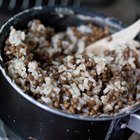
Rice & Lentil Diet

Does Rice Taste Different Depending on ...

How to Cook Petai

Can I Substitute Chickpeas for Black ...
Easy Stuffed Bell Peppers Recipe

How to Make a Braided Round Rasta ...

How to Freeze Lentils

How to Thicken Beef Stroganoff

How Many Calories in a Taco Bell Bean ...
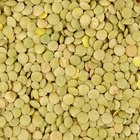
How to Cook Trini Style Lentils

Do You Have to Cook Ramps or Can You ...
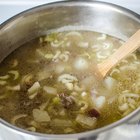
How to Make Potato Hamburger Soup

How to Roast Maple and Brown Sugar ...
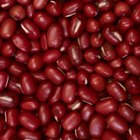
How to Soak Adzuki Beans

Nutrition From Beans & Rice

How to Clean Ecco Shoes
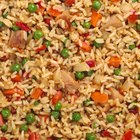
How to Cook Arroz Chaufa
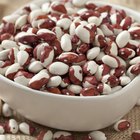
The Nutritional Value of Anasazi Beans ...

Alkaline Diet & Protein Foods

How Long After a Sell-By Date Can You ...
References
Resources
Writer Bio
Laurel Heidtman began writing for her hometown paper, "The Harrison Press," in 1964. In addition to freelancing she has worked as a police officer, a registered nurse, a health educator and a technical writer. She holds an associate degree in nursing, a Bachelor of Arts in English and a Master of Technical and Scientific Communication from Miami University of Ohio.
Photo Credits
ffolas/iStock/Getty Images